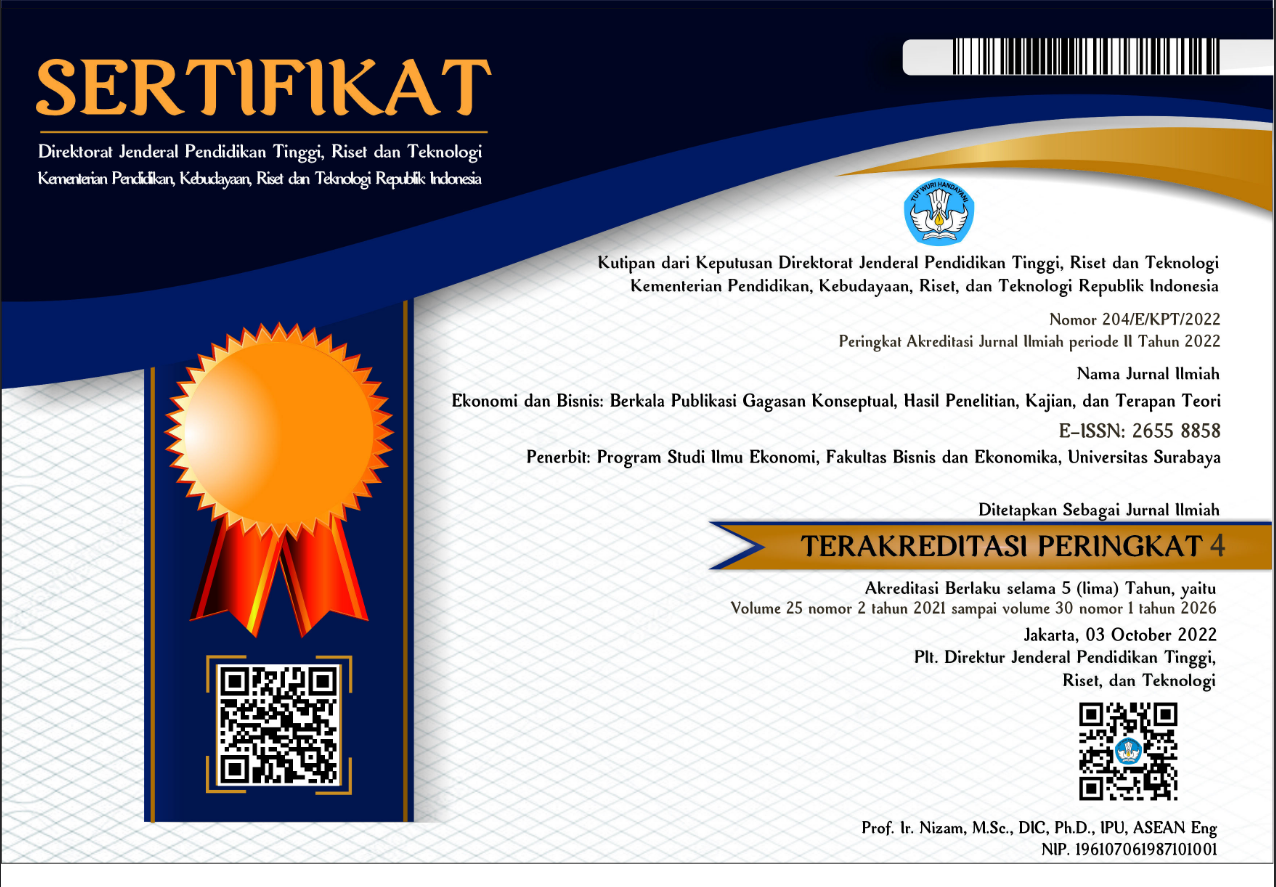BISNIS ONLINE: PREFERENSI KONSUMEN TERHADAP LAYANAN ONLINE FOOD DELIVERY
 Abstract Views:
517 times
Abstract Views:
517 times
 Nadiah Arum Mindarti, Made Siti Sundari, Sugeng Hariadi (Bahasa Indonesia) Downloads:
418 times
Nadiah Arum Mindarti, Made Siti Sundari, Sugeng Hariadi (Bahasa Indonesia) Downloads:
418 times
Abstract
This research studies the factors that influence consumers in using online food delivery services. The variables used are Time Saving Orientation, Price Saving Orientation, and Behavior Intention to OFD Services. The questionnaire is used in the data collection
process. Questions in this study were published online and offline. Online distribution is done through Google Form and offline distribution is done by distributing it to students of the University of Surabaya. A total of 208 valid questionnaires were collected to be
submitted using Structural Equation Modeling (SEM) data processing with SmartPLS software. Time Saving Orientation and Price Saving Orientation have positive and significant effect on Behavior Intention Towards OFD Services which support t-statistics
of 3,562 & 3,272 and P-Values of 0,000. The more culinary entrepreneurs who use e-commerce, the more transactions will occur, so it will increase the GRDP which will ultimately increase economic growth.
Downloads
References
Alreck, P. L., & Settle, R. B., 2002, The Hurried Consumer: Time-Saving Perceptions Of Internet And Catalogue Shopping. Journal Of Database Marketing, 10, 25-35.
Ball, S., 1999, Whither The Small Independent Take-Away? 101, 715-723.
Bellenger, D. N., & Korgaonkar, P. K., 1980, Profiling The Recreational Shopper,.
Bloch, P. H., Ridgway, N. M., & Dawson, S. A., 1994, The Shopping Mall As Consumer Habitat . Journal Of Retailing, 70, 23-42.
Chin, W., Marcolin, B., & Newsted, P., 2003, A Partial Least Squares Latent Variable Modeling Approach For Measuring Interaction Effects: Results From A Monte Carlo Simulation Study And An Electronic-Mail Emotion/Adoption Study. 2, 189-217.
Currie, W., & Parikh, M. A., 2006, Value Creation In Web Services: An Integrative Model. Strategic Information Systems, 15, 153-174.
Darke, P., Freedman, J., & Chaiken, S., 1995, Percentage Discounts, Initial Price, And Bargain Hunting: A Heuristic Approach To Price Search Behavior. 80.
Davis, F. D., 1989, Perceived Usefulness, Perceived Ease Of Use, And User Acceptance Of Information Technology. 13, 319-340.
Dawes, J., 2007, Do Data Characteristics Change According To The Number Of Scale Points Used? 50, 61-77.
Escobar-Rodríguez, T., & Carvajal-Trujillo, E., 2014, Online Purchasing Tickets For Low Cost Carriers: An Application Of The Unified Theory Of Acceptance And Use Of Technology (UTAUT) Model. Tourism Management, 43, 70-88.
Gudergan, S., Ringle, C., Wende, S., & Will, A., 2008, Confirmatory Tetrad Analysis In PLS Path Modeling. 61, 1238-1249.
Huff, S., Wade, M., Parent, M., Schneberger, S., & Newson, P., 2000, Case In Electronic Commerce.
Jarrat, D. G., & Polonsky, M. J., 1993, Causal Linkages Between Psychographic And Demographic Determinants Of Outshopping Behaviour. The International Review Of Retail, Distribution And Consumer Research, 3, 303-319.
Journal Of Retailing, 56, 77-92.
Kuo, Y., & Yen, S., 2009, Towards An Understanding Of The Behavioral Intention To Use 3G Mobile Value-Added Services. 25, 103-110.
Lunt, P. K., & Livingstone, S., 1992, Mass Consumption And Personal Identity: Everyday Economic Experience.
Nagle, T., Hogan, J., & Zale, J., 2010, The Strategy And Tactics Of Pricing: A Guide To Profitable Decision Making.
Pindyck, R. S., & Rubinfeld, D. L., 2009, Microeconomics. Pearson International Edition. Nicholson, W., 1995, Microeconomic Theory: Basic Principles And Extensions.
Rezaei, S., Shahijan, M., Amin, M., & Ismail, W., 2016, Determinants Of App Stores Continuance Behavior: A PLS Path Modelling Approach. 15, 408-44-.
Tauber, E. M., 1972, Marketing Notes And Communications. Journal Of Marketing, 4, 46-49.
Thaler, R. H., 2008, Mental Accounting And Consumer Choice. Marketing Science, 27, 15-25.
Turban, E., Lee, J., King, T., & Chung, H., 1999, Electronic Commerce: A Managerial And Social Networks Perspective. 8th Ed. New Jersey: Prentice Hall.
Tversky, A., & Kahneman, D., 1981, The Framing Of Decisions And The Psychology Of Choice. Science, 211, 453-458.
Verma, R., Dixon, M., & Kimes, S., 2009, Customer Preferences And Use Of Technology-Based Innovations In Restaurants: A Best-Worst Choice Analysis.

 DOI:
DOI:















